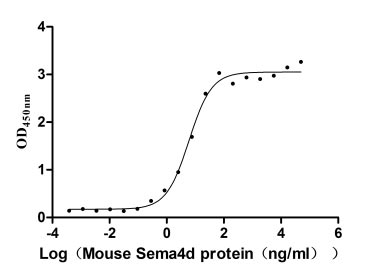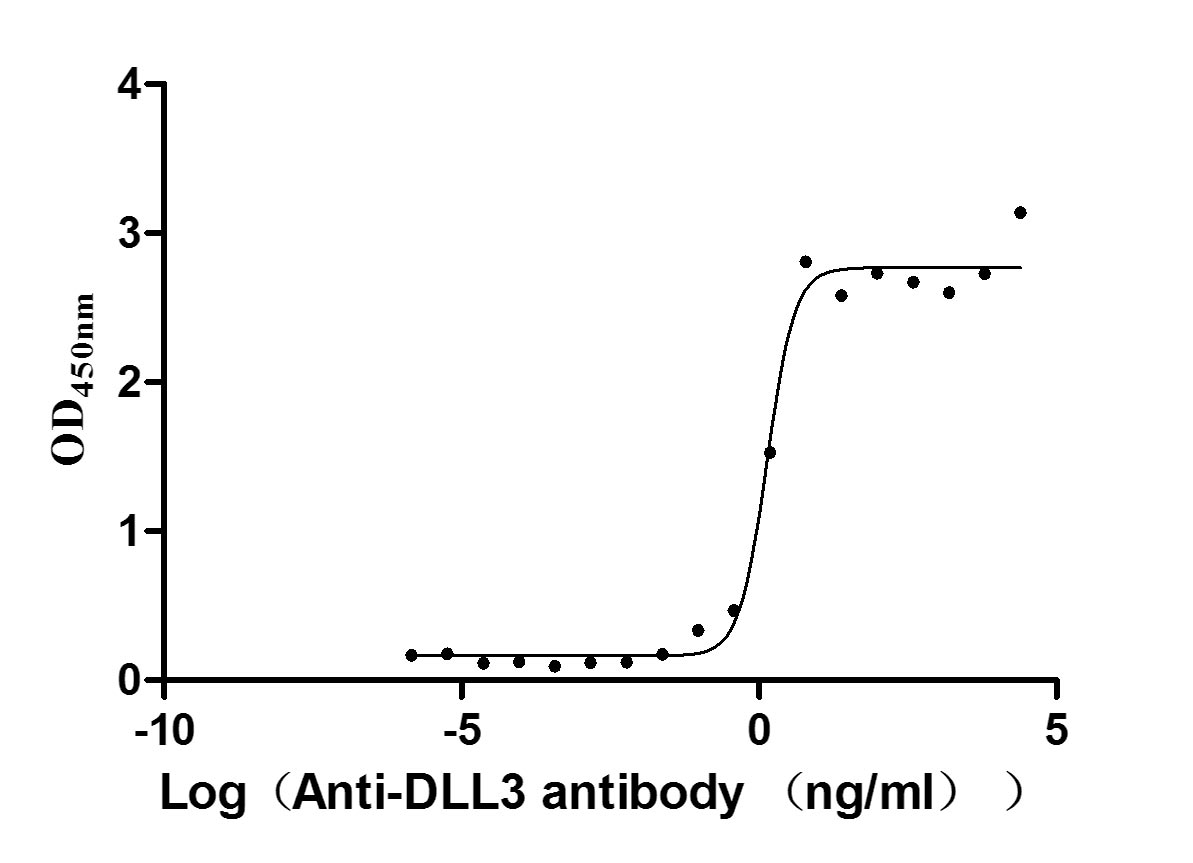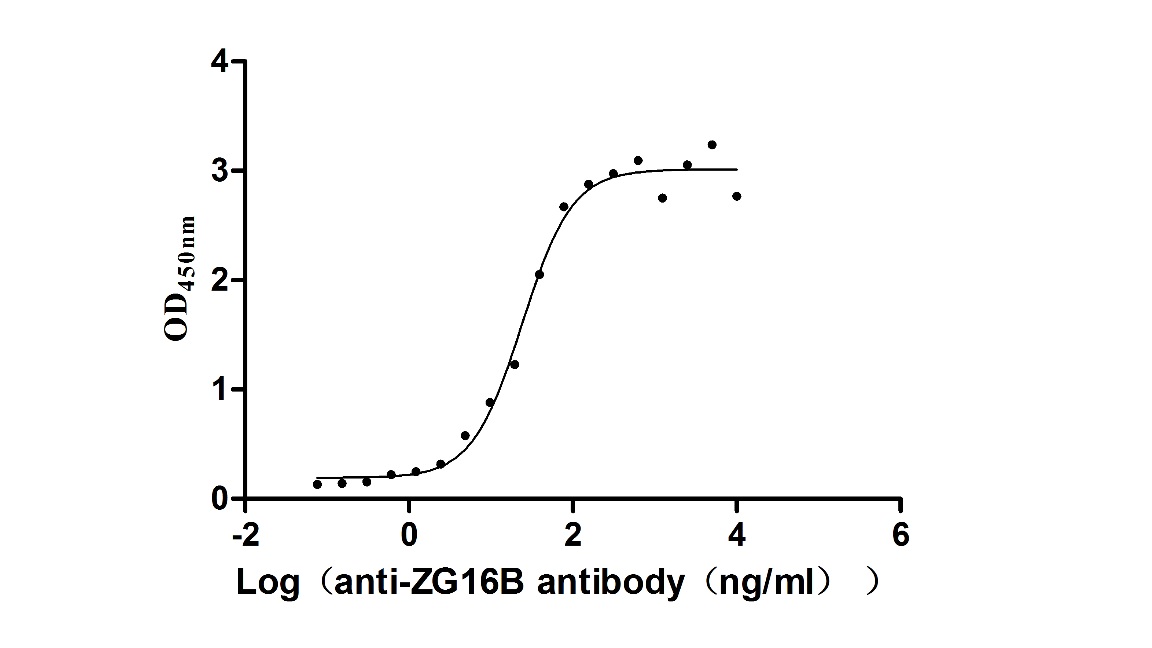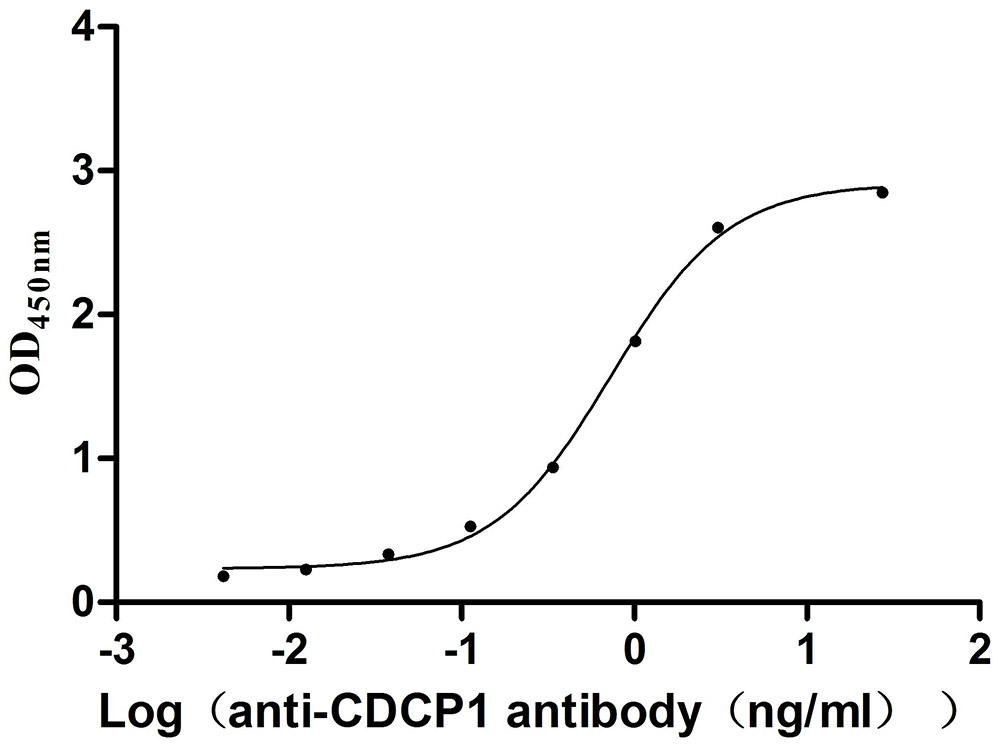Recombinant Human Proactivator polypeptide (PSAP), partial
In Stock-
货号:CSB-EP018836HU
-
规格:¥1344
-
图片:
-
其他:
产品详情
-
纯度:Greater than 90% as determined by SDS-PAGE.
-
基因名:PSAP
-
Uniprot No.:
-
别名:A1 activator; Cerebroside sulfate activator; Co-beta-glucosidase; Component C; CSAct; Dispersin; GLBA; Glucosylceramidase activator; Proactivator polypeptide; Proactivator polypeptide precursor; Prosaposin (sphingolipid activator protein 1); prosaposin (variant Gaucher disease and variant metachromatic leukodystrophy); Prosaposin; Protein A; Protein C; PSAP; SAP 1; SAP 2; SAP-1; SAP-2; SAP_HUMAN; SAP1; Saposin A; Saposin B; Saposin B Val; Saposin C; Saposin D; Saposin-D; Saposins; Sgp1; Sphingolipid activator protein 1; Sphingolipid activator protein 2; Sulfated glycoprotein 1; Sulfatide/GM1 activator
-
种属:Homo sapiens (Human)
-
蛋白长度:Partial
-
来源:E.coli
-
分子量:36.1kDa
-
表达区域:311-391aa
-
氨基酸序列SDVYCEVCEFLVKEVTKLIDNNKTEKEILDAFDKMCSKLPKSLSEECQEVVDTYGSSILSILLEEVSPELVCSMLHLCSGT
Note: The complete sequence including tag sequence, target protein sequence and linker sequence could be provided upon request. -
蛋白标签:N-terminal GST-tagged
-
产品提供形式:Liquid or Lyophilized powder
Note: We will preferentially ship the format that we have in stock, however, if you have any special requirement for the format, please remark your requirement when placing the order, we will prepare according to your demand. -
缓冲液:Tris-based buffer,50% glycerol
-
储存条件:Store at -20°C/-80°C upon receipt, aliquoting is necessary for mutiple use. Avoid repeated freeze-thaw cycles.
-
保质期:The shelf life is related to many factors, storage state, buffer ingredients, storage temperature and the stability of the protein itself.
Generally, the shelf life of liquid form is 6 months at -20°C/-80°C. The shelf life of lyophilized form is 12 months at -20°C/-80°C. -
货期:3-7 business days
-
注意事项:Repeated freezing and thawing is not recommended. Store working aliquots at 4°C for up to one week.
-
Datasheet & COA:Please contact us to get it.
相关产品
靶点详情
-
功能:Saposin-A and saposin-C stimulate the hydrolysis of glucosylceramide by beta-glucosylceramidase (EC 3.2.1.45) and galactosylceramide by beta-galactosylceramidase (EC 3.2.1.46). Saposin-C apparently acts by combining with the enzyme and acidic lipid to form an activated complex, rather than by solubilizing the substrate.; Saposin-B stimulates the hydrolysis of galacto-cerebroside sulfate by arylsulfatase A (EC 3.1.6.8), GM1 gangliosides by beta-galactosidase (EC 3.2.1.23) and globotriaosylceramide by alpha-galactosidase A (EC 3.2.1.22). Saposin-B forms a solubilizing complex with the substrates of the sphingolipid hydrolases.; Saposin-D is a specific sphingomyelin phosphodiesterase activator (EC 3.1.4.12).; Behaves as a myelinotrophic and neurotrophic factor, these effects are mediated by its G-protein-coupled receptors, GPR37 and GPR37L1, undergoing ligand-mediated internalization followed by ERK phosphorylation signaling.; Saposins are specific low-molecular mass non-enzymic proteins, they participate in the lysosomal degradation of sphingolipids, which takes place by the sequential action of specific hydrolases.
-
基因功能参考文献:
- Accumulating evidence suggests that PGRN is essential for proper lysosomal function, but the precise mechanisms involved are not known. Here, we show that PGRN facilitates neuronal uptake and lysosomal delivery of prosaposin (PSAP), the precursor of saposin peptides that are essential for lysosomal glycosphingolipid degradation. PMID: 28541286
- Both PSAP reduction and overexpression lead to significantly elevated extracellular progranulin (PGRN) levels. Intriguingly, PSAP knockdown increases PGRN monomers, whereas PSAP overexpression increases PGRN oligomers, partly through a protein-protein interaction. PMID: 27356620
- Study demonstrated that the binding of CST3 and PSAP decreased the inhibitory effects of CST3 on proteinase in vitro. The co-localization of both proteins was detected in cultured cells and in Bunina body-containing motor neurons from patients with amyotrophic lateral sclerosis, suggesting that they might be involved in the process of Bunina body formation. PMID: 29249381
- This report documents the successful use of plasma lysoSLs profiling in the PSAP deficiency diagnosis, as a reliable and informative tool to obtain a preliminary information in infantile cases with complex traits displaying severe neurological signs and visceral involvement. PMID: 26831127
- an extensive review of all the PSAP-causative variants published in the literature to date, accounting for a total of 10 PSAP allele types (review) PMID: 26462614
- Our findings suggest a novel pharmacological approach to Sap C deficiency directed to treat major secondary pathological aspects in this disorder. PMID: 25926625
- PSAP is a secreted biomarker. PMID: 26341737
- Data suggested that the abundance of Psap in sperm sample may be a sensitive endpoint to predict PCB exposure. PMID: 26045750
- Prosaposin facilitates sortilin-independent lysosomal trafficking of progranulin. PMID: 26370502
- findings support a lung metastasis-promoting function of the miR-23b/27b/24 cluster of miRNAs, which functions in part through the direct inhibition of PSAP in breast cancer PMID: 24966325
- Of the 2575 proteins identified, proteins upregulated in gallbladder cancer included several lysosomal proteins such as prosaposin, cathepsin Z and cathepsin H. PMID: 24657443
- Saposin C protects glucocerebrosidase against alpha-synuclein inhibition. PMID: 24070323
- Urine of patients with early prostate cancer contains lower levels of light chain fragments of inter-alpha-trypsin inhibitor and prosaposin fragment or saposin B. PMID: 23417432
- These findings suggested that prosaposin might enhance estrogen receptor alpha-mediated signaling axis and play a role in breast cancer development and progression. PMID: 22738294
- PSAP is a novel TFPI-2-interacting protein and that the binding sites are the KD2 of TFPI-2 and the C-terminus of PSAP. PMID: 21943334
- novel esophageal squamous cell carcinoma marker PSAP was identified by mass spectrometry and immunohistochemical analysis PMID: 21743296
- PSAP is a target gene of the BACH1 transcription factor according to ChIP-seq analysis in HEK 293 cells. PMID: 21555518
- saposin C caused stimulation of androgen receptor expression and activity by associations with Src kinases PMID: 21328455
- Saposin B(Sap B) is not a limiting factor of the coupled Sap B-arylsulfatase A reaction in mouse kidney cells even if sulfatide has accumulated to unphysiologically high levels PMID: 19224915
- The biological properties of cells from four recently described Gaucher disease patients carrying mutations in the Sap C domain of the PSAP gene have been characterized. PMID: 20484222
- PSAP is involved in prostate cancer invasion. PMID: 20132547
- reconstruction of the order of internal duplications that gave rise to the four saposins by using phylogenetic tools PMID: 11734895
- procathepsin D interacts with prosaposin in human breast and ovarian cancer cells. PMID: 12083803
- crystal structure reveals a dimeric shell for lipid binding PMID: 12518053
- data indicate that saposin C is required for acid beta-glucosidase resistance to proteolytic degradation in the cell PMID: 12813057
- The structure of saposin C compared to other saposin-fold family members provides an explanation for function variability of this protein family. PMID: 14674747
- model proposed in which saposin C exposes lipid antigens from intralysosomal membranes for loading onto CD1b PMID: 14716313
- There might be a potential pleuripotent regulatory function for prosaposin in prostate cancer. PMID: 15305334
- Amplification and overexpression of PSAP was studied in prostatic neoplasms. PMID: 16080200
- determination of crystal structure of human saposins A and C to 2.0 Angstroms and 2.4 Angstroms, respectively and both reveal the compact, monomeric saposin fold PMID: 16823039
- FSAP (Factor VII-activating protease) can cleave and inactivate PDGF-BB (platelet-derived growth factor-BB) and thereby inhibits VSMC (vascular smooth-muscle cell) proliferation. PMID: 17300216
- saposin B may facilitate lipid binding to CD1d molecules throughout the endocytic pathway PMID: 17372201
- an unglycosylated Sap-B variant, Asn215His, which causes a fatal sphingolipid storage disease, lost the ability to extract membrane lipids at acidic pH in the presence of BMP PMID: 17561962
- Expression of saposin C-originated saposin C may upregulate AR gene expression and activate the androgen receptor transcriptional function in an androgen-independent manner in prostate cancer cells. PMID: 17712477
- These data for the first time demonstrate that not only saposin C or PSAP regulates AR expression/activity, but also function as an androgen-regulated gene in prostate stromal cells. PMID: 18481277
- findings point to the role of lipid rafts in the prosaposin-triggered signalling pathway, thus supporting a role for this factor as a new component of the multimolecular signalling complex involved in the neurotrophic response. PMID: 18761669
- two new patients with PSAP gene defects; one, with pSap-d, who had a severe neurovisceral dystrophy and died as a neonate, and the other with SapB-d, who presented with a metachromatic leukodystrophy-like disorder but had normal arylsulfatase activity PMID: 19267410
- Report the up-regulation of prosaposin in the senescent fibroblasts and endothelial cells. PMID: 19471889
- Prosaposin functions in a paracrine and endocrine fashion by stimulating the expression of thrombospondin-1 (Tsp-1) in fibroblasts present in both primary tumors and distant organs, doing so in a p53-dependent manner. PMID: 19581582
- Saposin C or its precursor (PSAP) function as an androgen-agonist and upregulate androgen receptor and prostate-specific antigen expression/activity in androgen-responsive prostate cancer cells LNCaP, TRAMP-C1 and -C2., and CWR 22RV1. PMID: 17044040
- Prosaposin is an androgen-target gene and its expression in androgen-responsive prostate cancer cells can be upregulated by male hormones. PMID: 17171640
- Cloning of prosaposin gene from androgen-independent (AI) prostate cancer (PCa) cells and it genomic amplification in human metastatic AI PCa cell lines and punch biopsy samples of prostate cancer xenografts and lymph node metastases. PMID: 16080200
- Saposin C stimulates prostate cancer and stromal cells growth and invasion and uPA/uPAR expression, and activates p42/44 and SAPK/JNK signaling pathways of MAPK. PMID: 15897971
- Prosaposin and/or saposin C via modulation of caspases expression/activity and/or PI3K/Akt signaling pathway act as a survival and anti-apoptotic factor for prostate cancer cells. PMID: 15548330
显示更多
收起更多
-
相关疾病:Combined saposin deficiency (CSAPD); Leukodystrophy metachromatic due to saposin-B deficiency (MLD-SAPB); Gaucher disease, atypical, due to saposin C deficiency (AGD); Krabbe disease, atypical, due to saposin A deficiency (AKRD)
-
亚细胞定位:Lysosome.; [Prosaposin]: Secreted.
-
数据库链接:
HGNC: 9498
OMIM: 176801
KEGG: hsa:5660
STRING: 9606.ENSP00000378394
UniGene: Hs.523004
Most popular with customers
-
Recombinant Human Tumor necrosis factor receptor superfamily member 5 (CD40), partial (Active)
Express system: Mammalian cell
Species: Homo sapiens (Human)
-
Recombinant Human Glypican-3 (GPC3) (G537R), partial (Active)
Express system: Mammalian cell
Species: Homo sapiens (Human)
-
Recombinant Mouse Semaphorin-4D (Sema4d), partial (Active)
Express system: Mammalian cell
Species: Mus musculus (Mouse)
-
Recombinant Human Delta-like protein 3 (DLL3), partial (Active)
Express system: Mammalian cell
Species: Homo sapiens (Human)
-
Recombinant Rat Microtubule-associated protein tau (Mapt) (Active)
Express system: Mammalian cell
Species: Rattus norvegicus (Rat)
-
Recombinant Human IL12B&IL12A Heterodimer Protein (Active)
Express system: Mammalian cell
Species: Homo sapiens (Human)
-
Recombinant Macaca fascicularis zymogen granule protein 16 homolog B (ZG16B) (Active)
Express system: Mammalian cell
Species: Macaca fascicularis (Crab-eating macaque) (Cynomolgus monkey)
-
Recombinant Mouse CUB domain-containing protein 1 (Cdcp1), partial (Active)
Express system: Mammalian cell
Species: Mus musculus (Mouse)

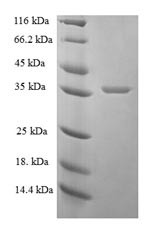


-AC1.jpg)
